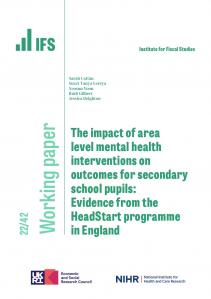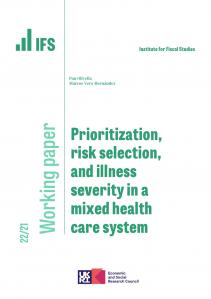Collection

Impartial and rigorous analysis on the decisions facing the Chancellor as part of the Autumn Budget and Spending Review of 2021.
Event
Autumn Budget and Spending Review 2021
28 October 2021 | Online
Slides from the event
Tax and spend by Carl Emmerson
PDF | 142.65 KB
Austerity over but not undone by Ben Zaranko
PDF | 297.63 KB
Business and indirect taxes by Stuart Adam
PDF | 143.85 KB
Fiscally speaking this year will go down as a once in a decade event. It’ll be up there with 1979 when Geoffrey Howe cut direct taxes, increased VAT and set out a new monetarist agenda, with 1993 the year of the huge Lamont and Clarke tax increases, and the start of a parliament of retrenchment, 2002 when Gordon Brown showed his real intentions to increase public spending substantially financed by tax rises, and 2010, when George Osborne set the stage for a long period of austerity.
To that list we can now add 2021. This is the year when a Conservative chancellor raised taxes by £40 billion or so; when the tax burden was put firmly on a path to exceed 36% of national income and hence settle at a record sustained level, a full 2.7 per cent of GDP higher than it was in 2019-20; and when public spending was increased across the board to take the size of the state back to levels not seen in normal times since the days of Geoffrey Howe.
It is important to be clear. This is almost entirely a set of policy choices unrelated to the pandemic. What we have had is a chancellor responding to the ever-increasing demands of the healthcare system on the one hand, and the increasingly dire plight of the likes of the justice, social care and prison systems, starved of funding for a decade, on the other. He has also presided over big increases in capital spending that were put in place by his predecessor.
Compared with pre-pandemic plans set out in March 2020 the big change has in fact been the health and social care levy. That has allowed spending on health to rise by 4% a year over the next three years without creating a squeeze on other departments. Otherwise what yesterday’s Budget did was largely take the spending rises pencilled in back in 2020, which had been rubbed out again by March 2021, and allocate them to spending lines other than health.
A crucial ingredient in this year’s policy decisions has been the way in which OBR forecasts appear to have driven policy. Back in March the OBR was forecasting a big long term hit to the economy which would have left borrowing well short of current budget balance – one of Mr Sunak’s key fiscal objectives. So, he announced big tax rises. With a more positive economic and fiscal outlook he has not decided to reverse any of those tax rises, he has decided to bank them, raise spending, and bring borrowing in below pre-pandemic forecasts.
Had he not topped up his spending plans he could have reversed a third of those March tax increases. This is a chancellor who has responded to a hole in the public finances by relying more than entirely on tax rises to do the repair job. Contrast that with his recent predecessors.
All this gives him some cushion against the OBR becoming more pessimistic again. Indeed, if the forecasts are correct he could find space for a pre election tax giveaway of perhaps £7 billion and still maintain some fiscal headroom. But, given his newly stated fiscal targets, it’s not a huge or comfortable cushion.
The main fiscal targets are as expected. He is targeting debt falling and current budget balance, both on a three-year rolling basis. Mr Sunak will be hoping he doesn’t have to answer the question – how to respond if forecasts change such that it looks like he’ll miss them. He surely won’t want to increase taxes even further. It would be quite a policy reversal to abandon his promised spending increases. Maybe like many other recent Chancellors he’d just live with missing the targets?
The worry for the government is that, for all the chancellor’s upbeat delivery, the voters may not get much feelgood factor. High inflation, rising taxes, and poor growth, still undermined more by Brexit than by the pandemic, will see real living standards barely rising and, for many, falling over the next year.
Public spending
The increases announced are real and substantial. No department is seeing a cut to its overall budget, and only Defence a cut to current spending. Some such as Justice which would have been braced for cuts are getting big increases. There is money in the short term to support services with additional costs arising from Covid. (It is in fact bizarre that implausibly low totals were pencilled in for next year in the first place). And the Chancellor has, sensibly, left himself with a larger than usual reserve to be allocated at a later date.
For many areas though spending will still be substantially less in 2024-25 than it was back in 2010. That will be true of justice and local government for example. Perhaps the most striking contrast lies in the different paths for health and education spending. Over this spending review period education spending is set to rise by about 2% a year against a 4% a year increase for the department for health and social care. Over the whole period since 2010, by contrast, health spending will have increased by over 40%, education spending by less than 3%. For the chancellor to have felt it appropriate to draw attention to the fact that per pupil spending in schools will have returned to 2010 levels by 2024 is perhaps a statement of a remarkable lack of priority afforded to the education system since 2010. A decade and a half with no growth in spending despite, albeit insipid, economic growth is unprecedented. Spending per student in FE and sixth form colleges will remain well below 2010 levels. This is not a set of priorities which looks consistent with a long term growth strategy. Or indeed levelling up.
One area that may still face a bit of a struggle is local government. Despite a real increase in spending power, tighter limits on what can be raised in council tax, the fact that grants are being frozen after next year, a continued failure to update funding formulae, and the demands of the social care system, could still see some local authorities having to cut services over the next few years.
It’s also worth noting that health spending was topped up again, partly because of a higher inflation forecast, and partly because the OBR expects the health and care levy is to raise a couple of billion more than the Treasury thought last month. The latter is a nonsense. We can be sure of two things. The amount the NHS needs is entirely unrelated to how much the levy will raise. And NHS funding would not have been cut if revenues had moved in the other direction.
One irritation to report. The pre briefings over the weekend of extra money for health and skills, for example, served only to obfuscate. Perhaps the Speaker was unduly concerned about the chancellor revealing too much of his Budget early. The truth is these briefings revealed less than nothing.
Living standards
The Chancellor’s presentation was upbeat. He claimed beforehand that this was a Budget “to usher in a new age of optimism”. Unfortunately for him, and for us, the outlook for living standards does not match this upbeat tone. Over the next several years a combination of tax increases and high inflation will mean very slow growth in living standards. A middle earner is likely to be worse off next year than this as high rates of inflation and tax rises more than negate small average wage increases. This of course comes on top of a decade of historically feeble increases in real incomes. The gap between what we might have expected on the basis of pre financial crisis trends and what is actually happening is staggering. Average gross earnings could have been some 40% higher had pre crisis trends continued.
The primacy of asset accumulation, and the importance of asset holdings, over the possibility of getting better off through earnings, is being maintained well into a second decade.
With, in the words of the OBR inflation quite possibly hitting its “highest rate in the UK for three decades” millions will be worse off in the short term. Next April benefits will rise by just over 3%, but inflation could easily be at 5%. That will be a real, if temporary, hit of hundreds of pounds a year for many benefit recipients. I recall, when I was studying in the 1980s, reading analyses from the 1970s of the hardship caused by inflation when benefits and earnings increases lagged price rises. We are not at 1970s levels of inflation, but we are now experiencing enough inflation that real pain will be felt as low income households – most of whom have next to nothing in the way of financial assets – wait more than a year for their incomes to catch up. For some in work that may never happen.
Two policies will benefit many low earners. The first is the uplift in the national living wage – one of the few points of continuity between Chancellor Osborne and Chancellor Sunak. Though even this increase of over 6% will feel less generous once inflation of perhaps 5% is taken into account.
The second, the cut in the Universal Credit taper and the increase in the work allowance, will, as the Chancellor claimed, benefit around two million in work recipients of UC. It will be worth about the same as the £20 a week uplift to a full-time worker on the minimum wage. One illustration of the trade-offs here. A lone parent with just one child and a relatively modest rent will now have to earn well over £40,000 a year to move off Universal Credit. The taper has been cut, but more people will be affected by it.
Overall the policies coming into effect in April will be highly progressive relative to the position today – gains for low earners and, as a result of the NI rise and tax allowance cuts, losses for higher earners. It remains the case though that the working age benefit system is overall substantially less generous than it was in 2015. Since then tax and benefit changes have hit the poor and favoured the better off. The position of those out of work, especially those without children, remains precarious indeed. No increase in out of work benefits for the childless unemployed for half a century leaves their living standards dramatically trailing those of the working majority. The gap between the generosity of the furlough scheme and the meanness of our out of work benefit system could hardly be more stark.
Conclusions
Unsurprisingly, given the scale of increases announced earlier in the year, the tax changes we heard about yesterday were modest. A welcome reform to alcohol taxation, and some modest tinkering with business rates and air passenger duty. The story of this Budget then is one of spending increases and a worrying outlook for living standards. The story of the fiscal year as a whole also encapsulates those historic tax increases.
In the end Mr Sunak has bowed to the demands created by public services which have suffered a decade of cuts, and to the inevitability of increased spending on the NHS. If he is to achieve the ambition he set out at the end of his speech to get taxes down and reduce the size of the state, then he is going to have to come up with some pretty new and radical ways to manage those pressures. He would be helped by an economy growing rather more enthusiastically than it has managed for some time now. Finding the key either to reforming public services to make them cheaper and more efficient, or to getting higher economic growth, are challenges which have defeated most of his predecessors.
The Chancellor has delivered his Autumn Budget and the Office for Budget Responsibility (OBR) has published a new set of forecasts for the economy and public finances. IFS researchers provide an initial reaction to these below.
IFS Director Paul Johnson said:
“The Government is now planning to spend more on public services, and to have a more generous system of universal credit, than it was intending pre-pandemic. The increases in universal credit for those in paid work are occurring alongside increases in the national living wage. This means that the Budget and Spending Review are much more similar to Gordon Brown’s than to George Osborne’s. To help fund the spending increases, the Chancellor confirmed big tax rises: this year has seen the biggest set of tax-raising measures since 1993. It now looks like a large part of those tax rises is to be spent rather than being entirely used to reduce borrowing as originally announced.
If implemented, this might be sufficient to push borrowing below that expected prior to the pandemic and to see debt falling as a share of national income. Of course there is huge uncertainty over the outlook for the economy and it remains to be seen whether the tax rises will actually be implemented as announced.
The coming year will also be a difficult one for living standards. For example, for middle earners rising inflation and tax rises mean their real take home pay is set to fall by around 1%.”
On the public finances
Stronger growth so far this year – and the Office for Budget Responsibility’s judgement that the long-term damage to the economy will now be 2% rather than the 3% assumed in March – meant that the Chancellor was handed a more favourable set of economic and fiscal forecasts. Borrowing this year was revised down by just over £50 billion – though is still forecast to be £183 billion. The only times when it has been higher were last year, during the global financial crisis and during the two World Wars of the twentieth century.
In later years, the forecast reduction in borrowing was less, in part due to Mr Sunak’s decision to top up departmental spending plans, to increase spending on Universal Credit, and to freeze alcohol duties and fuel duties. Borrowing in 2024–25 is now forecast to be £46 billion which is not just lower than the £74 billion forecast in March 2021 but also lower than the £58 billion forecast prior to the first lockdown in March 2020. This might be sufficient to see debt falling as a share of national income, though the forecasts are predicated on the large tax rises announced in March (specifically income tax and corporation tax) and September (the new health and social care levy) going ahead and not being offset with new tax cuts elsewhere.
Public spending
The Chancellor used the windfall from improved OBR forecasts to top up his spending plans for the second time in as many months. Today’s top-up, combined with the extra health and social care spending announced last month, means that by 2024−25, he’s planning to spend £10 billion more than he was planning pre-pandemic. That will mean day-to-day budgets growing by an average 3.3% per year in real-terms, a sizeable package of Covid support measures for affected public services, and real-terms increases for almost all departments.
These increases are broadly comparable to (if a bit smaller than) those planned by Labour governments in the 2000s. But the key difference is the extent to which these increases are swallowed up by the NHS. 44% of the cash increases announced in today’s Spending Review for the next three years will go to the Department of Health and Social Care. The equivalent figure last year was 45%. At the Spending Reviews between 1998 and 2007, the average share going to Health was 35%, and never rose above 38%. This explains why despite relatively big increases in headline measures of spending, things might still feel tight in other areas. Perhaps nowhere is this truer than in local government, where after a jump next year, grant funding for existing services will be more or less frozen in the following two years - bigger council tax rises than the government plans to allow could be necessary to maintain services.’
Living standards
Large swathes of the population face a squeeze on living standards over the coming year. Rises in National Insurance contributions and (through a freeze to the personal allowance) income tax in April will come on top of rising inflation, taking a significant swipe at people’s spending power.
According to the new forecasts, over the next year a median earner will find their pre-tax pay just about outpaces inflation, but after the extra income tax and NICs due their take-home pay will fall by about 1%, or £180 per year, in real terms.
Many lower earners will see increases in income, though inflation and tax rises will tend to make those increases much more modest than headlines might suggest. Before tax, about half of the 6.6% increase in the minimum wage will be eaten up by inflation over the next year, meaning a real-terms rise of about 3.2%. After tax this will become a 1.2% real increase in take-home pay for a full-time minimum wage worker.
Perhaps the biggest news from today is that those with the strongest prospects for income growth as we (hopefully) emerge from the epidemic are households with someone in paid work but with a low enough income to be on universal credit. These households will keep significantly more of their benefits as a result of today’s announcements. The gains will be especially large for those who also stand to benefit from the increases to the minimum wage. A full-time minimum wage worker who is also on universal credit will have their disposable income increase by around £250 per year as a result of next April’s increase in the minimum wage, and an additional £1,000 per year or more (depending on precise circumstances) as a result of the increases in universal credit announced today.
One bigger-picture takeaway on the direction of policy towards low earners is that the minimum wage and benefits will now be working together to provide relief to living standards. This marks a reversal on recent years when they have been in a tug-of-war, and sometimes (erroneously) presented as substitutes for each other – another way in which the Sunak and Osborne chancellorships are starkly contrasting.
A group who are likely to find the coming months especially tough are households without someone in paid work. Prices are set to continue rising relatively quickly over the winter while their benefits stay the same, and while many will still be adjusting to the removal of the temporary £20 per week benefit uplift. Ultimately, real income levels for those out of work are set to return to something similar to pre-pandemic – but the road there will not be smooth, as their spending power is set to be eroded by inflation before benefit rates ‘catch up’ in April 2022 and April 2023. And all of this comes in a context where the out-of-work safety net is substantially lower than a few years ago as a result of retrenchment pre-pandemic.
Alcohol tax
The government has announced a major overhaul of alcohol taxes. Rates will be frozen until February 2023, after which all types of alcohol will be taxed in relation to their alcohol content. The biggest changes are for wine, with sparkling and low-strength wine seeing a tax cut while higher-strength wine sees an increase. However, the proposed tax rates on cider are still much lower than those on beer, wine and spirits.
Kate Smith, IFS Associate Director said: “The reforms to alcohol duty announced in today’s budget are a very welcome step. The previous system was a mess. Moving to a system that taxes all drinks in relation to their alcohol content is sensible, while having higher rates on stronger products targets heavy drinkers. However, one anomaly from the previous system remains, with cider still taxed much more lightly than other drinks under the proposed reforms.”
Related content

Budget measures bring number of families entitled to Universal Credit to 7 million
8 November 2021

More spending doesn’t mean there’s going to be more cash for everyone
'The real problem is that spending can happily grow at 3 per cent a year if the economy is also growing at 3 per cent a year. It isn’t and it won’t, not least because of the chilling effect that Brexit will continue to have.'
25 October 2021

What might rising interest rates mean for different generations?
Earlier this week, markets reacted to comments by the governor of the Bank of England by bringing forward their expectations of when interest rates will rise. What will this mean for different generations?
22 October 2021

The rise and fall of borrowing through the pandemic: how does the UK compare?
By 2026, despite the sharp reduction in borrowing, the UK is forecast to see the second-biggest increase in government debt out of 28 economies for which comparable forecasts are available – with only the US seeing a bigger increase.
21 October 2021

The Chancellor should reform alcohol taxes in the Budget
Press reports suggest that the Chancellor is planning an overhaul of the UK’s system of alcohol duties. The current system, which raises about £12 billion a year, is certainly ripe for reform.
19 October 2021
Podcast
We recently published the IFS Green Budget, our flagship publication analysing at the outlook for the economy and the opportunities and challenges facing the Chancellor ahead of the autumn budget.
In our podcast, we speak to Benjamin Nabarro, Senior Associate at Citi Research, and Carl Emmerson, Deputy Director at IFS, to discuss the ongoing impacts of the COVID-19 pandemic, as the Chancellor aims to secure a lasting recovery and deliver on the government’s other objectives and priorities. The
IFS Green Budget is produced in partnership with Citi, and is funded by the Nuffield Foundation.
Collection details
- Publisher
- IFS
More from IFS
Understand this issue

Should we worry about government debt?
11 April 2024

Public investment: what you need to know
25 April 2024

The £600 billion problem awaiting the next government
25 April 2024
Policy analysis

Recent trends in and the outlook for health-related benefits
19 April 2024

4.2 million working-age people now claiming health-related benefits, could rise by 30% by the end of the decade
19 April 2024

Oil and gas make Scotland’s underlying public finances particularly volatile and uncertain
27 March 2024
Academic research

Do work search requirements work? Evidence from a UK reform targeting single parents
1 February 2023

The impact of area level mental health interventions on outcomes for secondary school pupils: Evidence from the HeadStart programme in England
13 October 2022

Prioritization, risk selection, and illness severity in a mixed health care system
16 June 2022